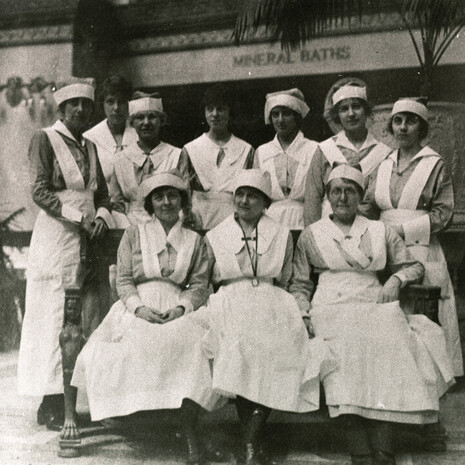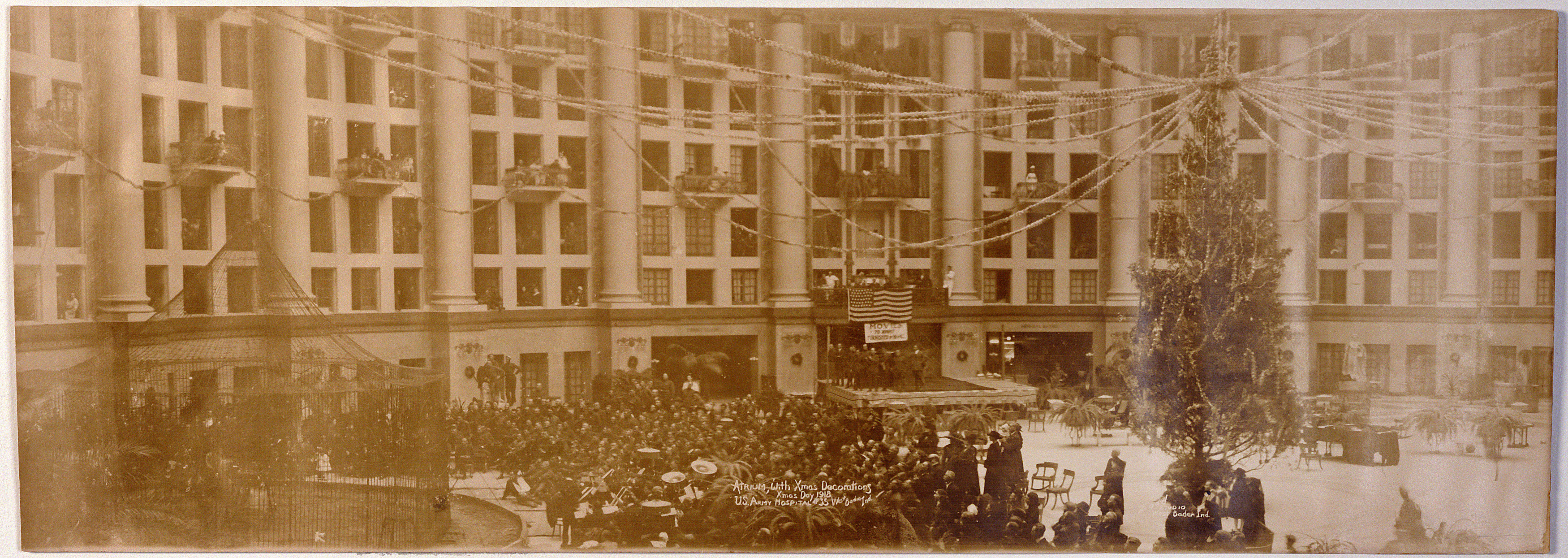PHONE: 888.936.9360
With the fighting intensifying in World War I, the U.S. government prepared for the influx of soldiers returning from overseas and military hospitals were needed for recovering soldiers. A patriotic spirit led business owners to offer their buildings to the War Department for modification into temporary hospitals. These large spaces could be converted much faster than barrack hospitals could be constructed and at less cost.
 Along with other resorts across the country, the Sinclair family offered the West Baden Springs Hotel and signed a lease with the U.S. Army on September 28, 1918. The agreement called for an annual payment by the government of $125,000 to the family for use of the hotel and its facilities. (That’s a little more than $2.4 million today.) Additionally, the government paid $72,191.65 for use of the furniture, linen, dishes, silver and other furnishings. Another $123,087 was spent converting the hotel into a hospital.
Along with other resorts across the country, the Sinclair family offered the West Baden Springs Hotel and signed a lease with the U.S. Army on September 28, 1918. The agreement called for an annual payment by the government of $125,000 to the family for use of the hotel and its facilities. (That’s a little more than $2.4 million today.) Additionally, the government paid $72,191.65 for use of the furniture, linen, dishes, silver and other furnishings. Another $123,087 was spent converting the hotel into a hospital.
The interior hotel rooms were used as professional offices for the doctors; specialty clinics for eye, ear, nose, throat, X-ray and dental; surgical rooms and wards for the sick. The dining room became the mess hall and the ballroom on the floor above it was converted into an 80-bed ward. The swimming pool was covered to create more floor space for barracks and the second floor of the natatorium was used by medical staff. The upper two floors of the garage (known today as The School House) were converted into barracks and the first floor was retained as a garage for military vehicles. The lobby, mezzanine above the lobby and the men’s smoking room (known today as the Library) all became wards. The only space of the hotel that remained unchanged was the atrium.
The first soldiers were admitted November 23. Because the hotel was known as a health resort, the government also retained employees and masseurs who gave mineral baths to help aid with the soldiers’ recoveries. At its peak 16 military nurses, 536 enlisted men, 24 commissioned officers and 50 civilians (including American Red Cross nurses) were employed by the hospital. Army General Hospital No. 35 had a high discharge rate with the typical patient staying an average of 16 days.
One of the most memorable events to happen in the atrium occurred during the hotel’s tenure as the Army hospital. On Christmas Day 1918, a special dinner was held for the patients and staff. Afterward the Sinclair family treated everyone to a free show by the Hagenbeck-Wallace Circus, which was owned by Ed Ballard and wintering at its off-season quarters in French Lick. A specially built cage was set up in the atrium and the first act was by six lions and their trainer, followed by a female horseback rider performing stunts. Next came five elephants and their handlers and closing the show was a clown and his two boxing dogs.

The sudden end of WWI led to the decision to close all temporary hospitals. Once most of the wounded soldiers had returned home in early 1919, the Secretary of War authorized the closure of Army General Hospital No. 35 on March 12 and it officially closed May 8. The transfer of new patients to the hospital ceased and patients still needing care were transferred to the base hospital at Fort Benjamin Harrison in Indianapolis.
During the hotel’s seven months as a hospital, 2,248 wounded or ill military patients were cared for and only two patients passed away.
Decommissioning the hospital (i.e. transporting personnel, medical equipment and supplies to other locations) took about six weeks. The West Baden Springs Hotel was returned to the Sinclair family on July 1. After being redecorated, refurnished and restocked the hotel reopened to guests in the late fall of 1919.